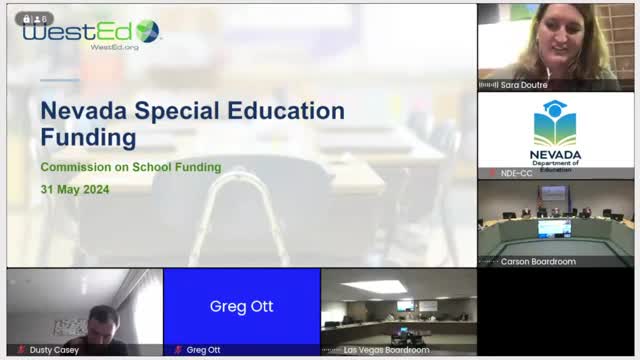Nevada grapples with outdated special education funding formula
June 01, 2024 | Department of Education, Executive Agencies, Organizations, Executive, Nevada

This article was created by AI summarizing key points discussed. AI makes mistakes, so for full details and context, please refer to the video of the full meeting. Please report any errors so we can fix them. Report an error »

In a recent government meeting, discussions centered on the complexities of special education funding in Nevada, highlighting significant disparities and the need for reform. The meeting featured a presentation by experts contracted by the Nevada Department of Education, who outlined the current funding framework and compared it to other states.
The presenters emphasized that special education is an individual entitlement under the federal Individuals with Disabilities Education Act (IDEA), which mandates that school districts provide a free and appropriate education to students with disabilities, regardless of funding levels. They noted that while federal funding is crucial, it currently covers only about 13% of the costs associated with special education, falling far short of the 40% envisioned when the law was enacted in the 1970s.
A key point raised was the outdated federal funding formula, which has not been revised since 1999. This stagnation has disproportionately affected Nevada, where funding per student with disabilities has increased by only 137% since then, the lowest in the nation. In contrast, other states have seen significantly higher increases, leading to inequities in funding distribution across districts.
The presenters also discussed the implications of Nevada's funding formula, which relies on a base allocation adjusted for inflation and a hold harmless provision designed to prevent funding decreases for local education agencies (LEAs). However, this approach has resulted in large disparities in funding amounts, with some districts receiving as little as $3,000 per student while others receive up to $12,000.
The meeting concluded with a call for policymakers to consider more equitable funding models that account for the varying needs of students with disabilities. The experts plan to return next month to delve deeper into the data and present further recommendations for reforming Nevada's special education funding system.
The presenters emphasized that special education is an individual entitlement under the federal Individuals with Disabilities Education Act (IDEA), which mandates that school districts provide a free and appropriate education to students with disabilities, regardless of funding levels. They noted that while federal funding is crucial, it currently covers only about 13% of the costs associated with special education, falling far short of the 40% envisioned when the law was enacted in the 1970s.
A key point raised was the outdated federal funding formula, which has not been revised since 1999. This stagnation has disproportionately affected Nevada, where funding per student with disabilities has increased by only 137% since then, the lowest in the nation. In contrast, other states have seen significantly higher increases, leading to inequities in funding distribution across districts.
The presenters also discussed the implications of Nevada's funding formula, which relies on a base allocation adjusted for inflation and a hold harmless provision designed to prevent funding decreases for local education agencies (LEAs). However, this approach has resulted in large disparities in funding amounts, with some districts receiving as little as $3,000 per student while others receive up to $12,000.
The meeting concluded with a call for policymakers to consider more equitable funding models that account for the varying needs of students with disabilities. The experts plan to return next month to delve deeper into the data and present further recommendations for reforming Nevada's special education funding system.
View full meeting
This article is based on a recent meeting—watch the full video and explore the complete transcript for deeper insights into the discussion.
View full meeting